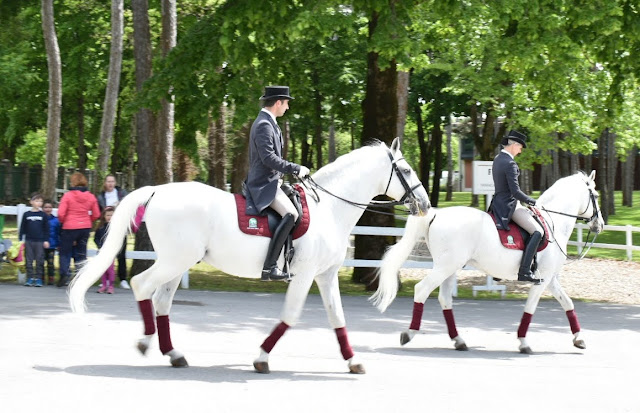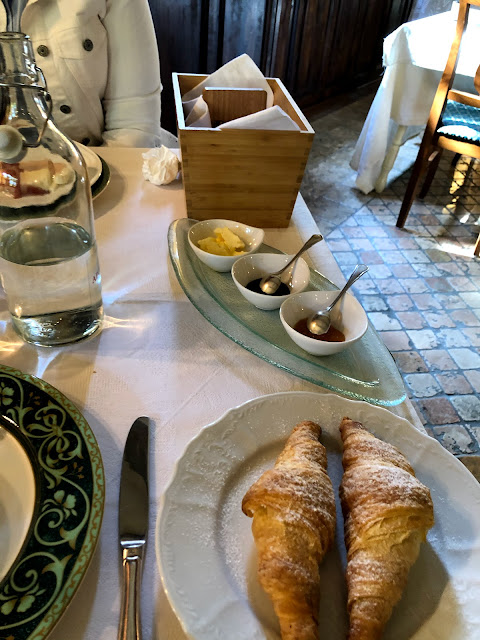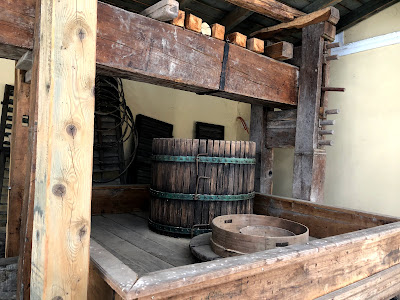A couple of months ago, when we were under fairly tight restrictions, the young missionaries arranged to meet a school teacher named Tomislav, at our apartment. He had responded to their Facebook offer to provide service to anyone who needed it. He wanted to set up a day when they could come to his 3rd grade class and tell them what it is like to grow up in America. We all wore masks as we spoke, but we made a good impression on him and he promised to let us know a date when classes resumed.
A week or so ago, the missionaries let us know they had a firm date to go to the school. They planned to go as a group of four - two elders and two sisters.
This is the sign in front of the school. It says "Osnova School Holy Sunday". The school was named for the Holy Sunday, commemorating the day the Turks withdrew from Slovenia after failing to penetrate into Austria in the 14th century.
A few days ago, the missionaries called us to let us know the school headmaster had contacted them with a request for us to present another 45 minute presentation on what "Mormons" believe, in the two 7th grade ethics classes. There are two groups of the ethics class to keep class-size down, so we would have to present it twice. And none of the other young missionaries had that day free, because quite a few of them had to go to the government for visa applications that day. So we were nominated.
Rules:
- we couldn't preach to them, nor
- solicit them to join the church.
We had three preparation days. Liz decided to do a Who, what, where, how type of presentation, and I agreed. Then we gathered up some films from the LDS Media website for missionaries, including a couple in the Slovene language. Two of the English-language videos were problems:
- The first one was "60 beliefs in 60 seconds". It is perfect because it is little clips of people from around the World saying a 1 or 2 word belief. But, it is in English and 1 per second is way too fast for children trying to translate from English into Slovene. We decided to go ahead and show it as-is first, and then challenge one of them to read the list of 60 Slovene words (which we had printed out) in the same time period. That worked OK. I'm sure they missed a lot, but we were only presenting an overview so it wasn't critical for them to get it all.
- The other problem film was a 1 minute film that used illustrations to explain how Christ's church had come to become so many denominations. Again, it went by very fast. It also introduced the idea of a church leader and twelve apostles. For this one, we asked the help of two young missionaries who are charged with media presentations and have a special computer to do that work. They slowed it down until it ran in about 3 minutes instead of 1, and overlaid the soundtrack with their own reading of the text in Slovene. This one was a big hit, but we think that was because they were laughing at our American pronunciation of their language. Whatever, it was fun.
I took my laptop to the school, which we connected to their projector. That way I could move through the slides in our presentation and play the movies. We took turns explaining. It was very stressful, especially for me, because I was still editing the slide show up to the very second we left. But presenting it was fun. The kids were polite and attentive and interested.
We were met outside the school by the headmaster and (we think) the headmistress, whose name is Mirriam. They stayed with us the whole time we were there and she helped us with translation when needed. We went straight into the first class and gave our presentation, and then we had an hour off until we were scheduled to do the other class. So, they took us to the teacher's lounge and fed us the morning snack - a sausage-vegetable soup with bread and fruit. We were surprised they fed us, but they thought it was perfectly ordinary. The have a big commercial kitchen with several cooks who serve three meals (they call two of them snacks) to all the children who want them, every day. As we ate, the headmaster asked us if we'd like a tour of the school, which we gladly accepted.
How did I miss taking an outside photo of the school? However, I did take a photo of this doorway between the old part of the school and the new.
The two square pieces on each side, at shoulder height, say 18 and 16, so the door was placed in 1816. That is for the new part of the school. Of course, it is built of stone and masonry. Apparently it is traditional to rub the keystone when you pass through. It looks like maybe you rub any food off your hands onto it.
The school is very well equipped with modern equipment, but they wish they had a new building. It does have a LOT of stairs. They are obviously very proud of the school, which they invariably described as "our school". During the tour, I asked if they teach how to keep honeybees, and the headmaster said they don't anymore, but would I like to see the bees at the previous headmaster's house after we finished our next presentation? Of course I said yes.
The previous headmaster was there for 40 years and had only recently retired. He lives just down the hill from the school.
This sign as at the entrance into the former headmaster's yard. He is Mr. Skok. The sign says, "Beehouse Skok - Domestic honey and beehive products".
The sign at the front of the yard is not just a sign. The little white disc at the bottom side of the sign is an adjustable bee entrance. The front of the sign opens up and you can see the bees inside through glass. They don't have any bees inside, yet, but it is a favorite of the children during the summer holidays.
It turns out the teacher who invited us there is the new Mr. Skok in school, and he is also a partner in the bee business. He called for his father, who was in the garage making new frames to go inside the beehives.
Most of the hives were bustling with bees. They collect pollen in the hives on the bottom row, honey in both the middle and bottom rows, and the very small hives on top are for catching swarms and raising new queens. But almost all the work of managing the bees is done inside the long shed.

The backs of the hives are along the walls on the left. On the top shelf at the right, you can see the new frames like he was making, with wax foundation already inserted. Various tools and supplies are scattered about, but generally it is well organized. There are two chest refrigerators they use to store frames of honey until they are ready to extract the honey from the frames.
When I think of all the days I've spent in a heavy bee suit under the hot, Texas sun, it almost makes me sick to see this wonderful arrangement where these Slovenian beekeepers work in the shade and peace of their sheds. The bees defend their entrances, so they remain fairly calm in the dim light of the shed, even when the back door of their hive is opened.
This hive had a screen instead of a back door, and Mr. Skok opened it up so I could see his Carniolan bees. This is the only kind of bees allowed in Slovenia, by law. They are grey instead of the bright yellow of Italian bees or the black of Russian bees. They are reputed to be very calm and easy to manage, though prone to swarm very frequently.
After we left the bee yard, we walked over to the church and castle.
The round turret is typical of a Templar building.
As we walked the short distance past the church to the castle, the headmaster asked me if I knew about "Holy Day". I told him we celebrate Good Friday, Christmas and Easter. So, he told me about the Turkish invasion and the great day when they negotiated the Turkish withdrawal in the 14th century. Apparently, the templars built this church and castle right after to make sure they remained withdrawn. I told him I knew a little about the templars. But he surprised me when he told me that the templars still send money to maintain this church and castle. I told him I'd thought the templars were wiped out on black Friday (Friday the 13th), but he said that was only in Italy, France and some nearby countries. Of course, the Rothschilds are descendants of the templars, who invented banking, so that is who sends them money, still identifying themselves as Templars.
I can't believe I didn't take a photo of the outside of the castle with its round corner turrets. Grrr.
When we entered the castle there were a lot of old museum pieces of farm equipment. There is a museum there, but it was closed after the Dec. 29, 2020 earthquake, which centered in Croatia, but cracked the outside wall of the castle in one place, forcing closure of the museum.
These two photos are of a huge press. It could be set up to press wine, or to hold millstones to grind flour. The size of it is mind-blowing! Compare it to the full-size road motorcycle.
A Templar cross in cobblestones inside the castle.
This well still has water. It is about ten feet across and has a geared machine to lower a bucket. When the castle was full of knights and maids it took a lot of water, I guess.
The castle is currently occupied by "social residents" - people who can't afford a place to live. The Templar church grants them space in the castle. It wasn't exactly bustling, but you can see a modern garbage can in the corner behind the well. We saw several doorways with unmistakable signs of residence.
After the tour of the castle we returned to the school for lunch.
Fried chicken patties, rice, vegetable soup, corn, green salad, fresh fruit, and deep-fried croissants filled with orange-apricot jam. It was piping hot and very, very good.
When we finished, the headmaster asked us if he could take a photo of us all together. So we went out front of the school.
The headmaster, Liz, me (the only one wearing a mask), Sisters Hart and Williams, Tomislav (the teacher who invited us), Elders Kunzler and Miller, and Mirriam.
A group of students were nearby and they wanted their photo taken with us, too.
This is only the students who happened to be outside when we took the photos.
The final thing that happened was the school presented each of us a parting gift: a jar of the Skok's Floral honey in a nice gift box, for each one of us. It is wonderful honey, too.
Jeruzalem is the town just to the east. I think it has a catchier name than Osnova.
Altogether, this was a marvelous day. We hope we can return many times.



















































